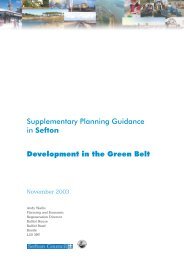The impact of sand extraction at Formby Point ... - Sefton Council
The impact of sand extraction at Formby Point ... - Sefton Council
The impact of sand extraction at Formby Point ... - Sefton Council
Create successful ePaper yourself
Turn your PDF publications into a flip-book with our unique Google optimized e-Paper software.
15<br />
Slack 2 was progressively invaded by mainly Grey Willow over a thirty year period, until<br />
2005 when site managers removed all but the rare hybrid willows, there being now eight<br />
S. x friesiana bushes and, nearby, one <strong>of</strong> the n<strong>at</strong>ionally scarce Salix x subsericea (16<br />
post-1987 hectads in the British Isles). Follow-up surveys (Smith 2007b) showed th<strong>at</strong> the<br />
cleared slack was colonised by 139 vascular plants, 28 being new to the NNR and 11<br />
regionally/n<strong>at</strong>ionally notable.<br />
<strong>The</strong> western borrow-pit (slack 1), being wetter than the adjacent dunes and slacks, has<br />
large areas <strong>of</strong> semi-aqu<strong>at</strong>ic veget<strong>at</strong>ion, including stands <strong>of</strong> Common Reed (Phragmites<br />
australis), Sea Club-rush (Bolboschoenus maritimus), Blunt-flowered Rush (Juncus<br />
subnodulosus) and W<strong>at</strong>er Horsetail with some Shore Horsetail. Dryer fringes are rich in<br />
slack plants such as Marsh Helleborine, marsh-orchids, Yellow Bartsia (Parentucellia<br />
viscosa) (regionally notable) and Grass-<strong>of</strong>-Parnassus. In the dryer, eastern borrow-pit<br />
(slack 3), the l<strong>at</strong>ter species achieves arguably its gre<strong>at</strong>est abundance in the entire dune<br />
system, assisted by heavy Rabbit-grazing which reduces competition from taller-growing<br />
plants.<br />
Slack 1 has been repr<strong>of</strong>iled several times since its form<strong>at</strong>ion in <strong>at</strong>tempts to improve its<br />
value as a N<strong>at</strong>terjack Toad breeding site. Most recently, in 2006, a central section was<br />
lined with fresh <strong>sand</strong>. This was used for spawning by a few N<strong>at</strong>terjacks but also,<br />
unfortun<strong>at</strong>ely, by large numbers <strong>of</strong> Common Toads.<br />
This borrow-pit is also deep enough to support Odon<strong>at</strong>a in some years, species recorded<br />
here including Emerald Damselfly (Lestes sponsa), Emperor (Anax imper<strong>at</strong>or), Migrant<br />
Hawker (Aeshna mixta) and Common Darter (Sympetrum striol<strong>at</strong>um).<br />
3. Ecological <strong>impact</strong> <strong>of</strong> <strong>sand</strong>-winning: positive and neg<strong>at</strong>ive trends<br />
Because detailed records were not kept before about 1970, it is now difficult to assess the<br />
ecological <strong>impact</strong> <strong>of</strong> <strong>sand</strong>-winning. Clearly, when it first took place there must have been<br />
c<strong>at</strong>astrophic disruption to ecosystems, including loss <strong>of</strong> habit<strong>at</strong>, local species extinctions<br />
and destruction <strong>of</strong> soils and seed-banks. Increased <strong>sand</strong>-blow may also have affected















